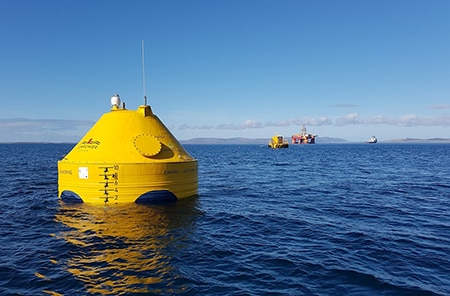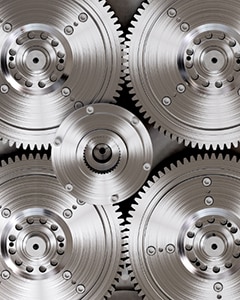An overview of the technology being used to harvest energy from the ocean's waves.
New Sources of Clean Power
Although efforts are underway to adopt sustainable energy worldwide, statistics from the International Energy Agency (IEA) show that more than 80% of the world’s energy is still derived from fossil sources such as oil, coal, and gas. Advancing technology has improved the efficiency of wind and solar energy; however, both combined still account for a small share of total power generation. Adopting new sources of clean power, such as the energy harnessed from the movements of the waves in the ocean, will contribute greatly to reducing the world’s dependence on fossil fuels.

Figure 1: CorPower Ocean’s C4 Wave Energy Converter
Source: CorPower Ocean/ABB
Advantages of Wave Power vs. Other Methods
Up until now, wave energy has been virtually non-existent; however, ocean waves have characteristics that make them well-suited to generating power. The currents of the oceans are very predictable. Winds may not always blow and the sun might be covered by a thick layer of clouds, but ocean waves will always arrive at the world’s coasts. As such, wave energy can be combined with wind and solar energy to yield a stable mix of clean power. So far, fossil fuels have had the advantage in being able to deliver 24/7 power every day of the year. The addition of wave power, could give renewable energy this all-important capability.
According to Patrik Möller, CEO of CorPower Ocean, the west coasts of Europe, the Americas, Indonesia, India, Africa, Australia, and many island nations have good wave conditions for power generation. In these regions, swells are created from multiple weather systems over a long period of time. Areas with such swell have the largest potential for generating wave energy, with little or no correlation to wind or solar conditions.
How does a Wave Energy Converter work?
In his 1986 thesis, Cardiac Pumping and Function of the Ventricular Septum, Stig Lundbäck, cardiologist and cofounder of CorPower Ocean, described his discovery that the pumping action of the human heart differed from the then prevalent view. Instead of using visible contractions to push the blood out, Dr. Lundbäck discovered that a healthy heart performs the pumping action without substantially changing its outer shape and volume. The heart instead relies on a movable valve plane, the inner wall containing atrioventricular heart valves and the connections of the aorta and pulmonary artery. During ventricular systole, the expulsive phase of the heart cycle, the valve plane presses downwards, towards the apex of the heart, forcing the blood present in the ventricles into the body. When the heart relaxes (ventricular diastole), the valve plane is pushed back to its original position by the pressure from the inflowing blood. Because of this automatic reset, the muscles of the heart are only required to pump in one direction.

Figure 2: The behavior of a DAPP pump
Source: Google Patents
This discovery inspired Dr. Lundbäck to develop a new type of pump mechanism, dubbed the Dynamic Adaptive Piston Pump (DAPP). Figure 2 is a diagram taken from Dr. Lundbäck’s patent for the DAPP system. The DAPP system consists of an upper cylinder (a) and a larger lower cylinder (b) stacked vertically with a smaller movable cylinder (c) in between them (Figure 1). When the movable cylinder shifts downwards, the pressure of the fluid inside forces the outflow valve (e) at the bottom of the lower cylinder to open, and the contents are expelled (Figure 2). With the lower cylinder empty, the pressure from the liquid beneath the unit pushes the outflow valve closed (Figure 3). Then, with the movable cylinder at its lowest position, more fluid flows into the upper cylinder . The pressure of the incoming fluid forces the valve (d) at the bottom of the movable cylinder to open (Figure 3). The internal redistribution of the contents causes the movable cylinder to automatically move back to its upper position and creates pressure to close the valve at the bottom of the movable cylinder (Figure 4).

The DAPP concept is used in CorPower Ocean’s C4 Wave Energy Converter, the company’s first commercial-scale harvester of wave energy. The system is essentially a buoy with a pre-tension system within to pull the buoy downwards. The buoy is 18 meters tall and 9 meters in diameter. Wave swells carry the buoy upwards. The buoy is forced back downwards by the stored pressure inside a pneumatic cylinder. Pneumatic cylinders (also known as an air cylinders) use compressed gas to move a piston in the desired direction. The buoy’s up and down motion is converted to energy using a mechanical drivetrain, with gears that rotate relative to the bobbing movements. The buoy is attached to the seabed using a UMACK (Universal Mooring, Anchor & Connectivity Kit) anchor.
The major challenge in wave energy harvesting system is weather conditions; wave power harvesters must be designed to withstand the stormy conditions that plague the oceans. The C4 features a unique phase control technology that allows the tuning of the system. In normal conditions, the C4 is tuned and set for optimal timing with the movement of the waves. In stormy weather conditions, the C4 is detuned, limiting the buoy’s movement in the presence of dangerous waves.
Each C4 is rated at 300kW and designed to be installed as part of a CorPack cluster, which is rated at 10-20MW. CorPack clusters are the building blocks of large-scale wave farms.
Figure 3: CorPower Ocean C4 Wave Energy Converter
Power and Automation
Shop our wide variety of Power and Automation products by ABB.
Don't forget to join our discussion.
The Partnership between CorPower Ocean and ABB
CorPower Ocean has established a partnership with ABB Ltd., who provided several essential components for the prototype of the C4. ABB Motion provided two medium-voltage motors: one to drive the test rig, and a second to handle energy storage. ABB Motion also provided the switchgears to power the motors, as well as frequency converters. Transformers were provided by ABB Power Grids Sweden. After successful testing and the completion of the C4, ABB and CorPower Ocean now look forward to building a full-scale fleet of C4’s in order to generate wave energy in a power grid.

Figure 4: Inside the C4, a mechanical drivetrain converts the buoy’s motion into energy
ABB Ltd. provides several products and services that contribute to sustainability and help reduce the world’s reliance on fossil fuels. Over half of ABB’s global sales consist of technologies that support enhanced sustainability, which includes renewable energy technology.
Summing up: Harnessing the Power of the Oceans
in partnership with

Advancements in renewable energy technology is enabling a reduction in the use of fossil fuels; however, energy sources such as wind and solar power are still heavily dependent on atmospheric conditions. The ocean’s currents are much more predictable, and harnessing the movements of waves could become a reliable way to generate power. CorPower Ocean, in partnership with ABB Ltd., is well on its way to such a solution. In the next few years, power will not only come from wind and the sun, but from the currents of the oceans as well.
How long will it take for green energy to replace fossil fuels, and what advancements are needed to get there?
Please tell us in the Comments section below.
